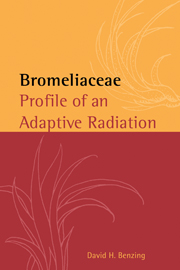1 - Introduction
from Part one - Brief overview
Published online by Cambridge University Press: 19 January 2010
Summary
Lower and middle Cretaceous Magnoliophyta remain too poorly known to warrant definitive statements about many aspects of early angiosperm radiation (Taylor and Hickey 1992). Discovery of a compressed infructescence purportedly from the Late Jurassic of east central Asia has recently expanded its confirmed record (Sun et al. 1998), and raises the specter of more fossils and better resolution ahead. Nevertheless, until this promise is realized, answers to questions as fundamental as the habits (woody vs. herbaceous) of ancestors and the homologies of diagnostic organs (e.g., the gynoecium) will remain speculative. One point germane to bromeliad history is less equivocal: characteristic pollen and macrofossils indicate that Liliopsida had emerged by the middle Cretaceous. However, evidence from several quarters indicates that Bromeliaceae evolved later, and probably not before the Tertiary.
Phytogeography also accords with youth that denied Bromeliaceae opportunity to range beyond tropical America except for a single, probably recent dispersal to west Africa (Fig. 1.1). Members of the three subfamilies (sensu Smith and Downs 1974, 1977, 1979) and many of the larger genera (e.g., Neoregelia, Hechtia) further suggest either exceptionally low mobility (unlikely) or too little time to cross barriers breached by many other lineages. Nevertheless, most authorities (e.g., Cronquist 1981; Dahlgren et al. 1985) consider Bromeliaceae phylogenetically isolated among the extant monocots, and a growing body of information on the organization of several sequences of nucleotides within the chloroplast genome (e.g., Ranker et al. 1990; Terry et al. 1997a,b) supports this conclusion.
- Type
- Chapter
- Information
- BromeliaceaeProfile of an Adaptive Radiation, pp. 3 - 16Publisher: Cambridge University PressPrint publication year: 2000
- 2
- Cited by



